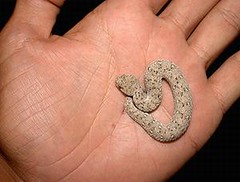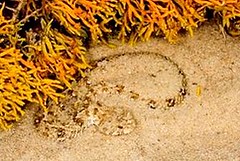 全世界最小的毒蛇目前處於世界自然保育聯盟(IUCN)《瀕危物種紅皮書》的易危(VU)等級,但根據密切研究這種動物的科學家表示,其族群量較先前所知的還要高,紅皮書的登錄資料也將隨之更新。
全世界最小的毒蛇目前處於世界自然保育聯盟(IUCN)《瀕危物種紅皮書》的易危(VU)等級,但根據密切研究這種動物的科學家表示,其族群量較先前所知的還要高,紅皮書的登錄資料也將隨之更新。
Witwatersrand 大學動植物與環境科學院的 Bryan Maritz 已研究納馬瓜侏儒蝰(Namaqua dwarf adder, Bitis schneideri) 多年,並把這種蛇當成其博士論文主題。
這種迷你的小蛇平均體長只有20公分,體重不超過38公克。納馬瓜侏儒蝰只有在納米比沙漠的沙丘以及全球唯一的乾旱型生物多樣性熱點- Succulent Karoo 生物群落區。
直到最近開採鑽石活動以前,該區多數地方受到管制,不過擁有該區多數土地的戴比爾斯集團 (de Beers Corporation) 捐出了大片的土地給南非國家公園局,現在該區已可進行有限度的觀光。
在非洲大陸,過去只有不到 20 篇有關蛇類生態的研究,而 Maritz 對這種小蛇有限的分佈範圍感到興趣,並提出了一些關於這個物種生存的問題。
他發現這種蛇的族群密度大約是每公頃 8 隻,並做出這種蛇並沒有滅絕危險結論。
 一般的無線電發射器對這種蛇來說太重,不過 Maritz 利用瞬間膠安裝在蛇尾的微型發報器解決了這個問題。當蛇脫皮的時候,發報器會隨著皮膚一同脫落。
一般的無線電發射器對這種蛇來說太重,不過 Maritz 利用瞬間膠安裝在蛇尾的微型發報器解決了這個問題。當蛇脫皮的時候,發報器會隨著皮膚一同脫落。
Maritz 發現,對這種毒蛇在沙漠的適應性來說,在這個乾旱的棲地中,解釋體型大小比相對缺乏獵物來說更為重要。
這個地區由獨特的動植物族群所組成,仰賴在海岸外流過且富饒的本格拉洋流(Benguela current)。每年降雨量不超過50到150公厘。雖然在白天有很大的變動,這裡的溫度維持在夏季攝氏18.2度與冬季的攝氏14.3度之間。
由於本格拉洋流對沙漠氣候的調節效應,Maritz 發現納馬瓜侏儒蝰可以整年度獵食,不像其他毒蛇在冬季停止覓食。由於這樣的獵捕與覓食能力,讓納馬瓜蝰每年都可以繁殖,而不像其他毒蛇近親隔一年才繁殖。
Maritz 說,這種毒蛇生存的另一個關鍵因素是他們的晝夜活動習性。大多數相類似的毒蛇都是夜行性的,而納馬瓜蝰則在白天獵食,偶而則在晚上獵捕。
 它不浪費能量獵食,而是半掩埋在沙中突襲它的獵物,像是蜥蜴、雨蛙、侏儒鼠以及其他小動物。
它不浪費能量獵食,而是半掩埋在沙中突襲它的獵物,像是蜥蜴、雨蛙、侏儒鼠以及其他小動物。
Martiz 認為納馬瓜侏儒蝰的體型大小是它能夠掩埋在沙中幾近隱形的關鍵。他說,如果是比較大的蛇,那麼躲在沙中的能力就會受限。
早晨帶有溼氣的雲飄過沙漠上空時,會留下一些水份降到沙中,使表層下方濕潤。使得納馬瓜侏儒蝰在沙的表層下方等待獵物,剛好可以「調節溫度」。
這種毒蛇對人類來說並不危險,但足以殺死比它體型大上一倍的獵物。
Maritz 說,「這個大陸上有非常豐富的兩棲爬行動物,應該進行更多的研究。」
The world's smallest viper, now classed as Vulnerable to extinction, has been discovered in greater numbers than previously known and will soon be upgraded on the IUCN's Red List of Threatened Species, according to the scientist who has studied these tiny snakes most closely.
Bryan Maritz of the University of the Witwatersrand's School of Animal, Plant and Environmental Sciences, has spent years studying the Namaqua dwarf adder, Bitis schneideri, as the focus of his PhD thesis.
The average length of these tiny snakes is just 200 millimeters (7.87 inches) and they weigh less than 38 grams (1.34 ounces).
The Namaqua dwarf adder is found only on the sand dunes of the Namib Desert and in the Succulent Karoo biome, the world's only arid biodiversity hotspot.
Most of the area was off limits until recently due to diamond mining activity, but the de Beers Corporation, which owned much of the land, has donated large tracts to the South African National Parks Board. Limited tourism is now permitted in the area.
On the African continent, where fewer than 20 studies on the ecology of snakes have ever been conducted, Maritz became interested in the little viper's limited range and the question of its survival as a species.
He found approximately eight individuals per hectare (2.5 acres) and so concludes that the snakes are not vulnerable to extinction.
Most common radio transmitters are too heavy for the snakes to bear, but Maritz resolved this problem with miniature transmitters that he placed near the snakes' tails with super glue. During moulting, the adders shed the transmitters along with their skins.
Maritz has found that the viper's adaptation to the desert sand is more important in explaining its size than the relative scarcity of prey in this arid habitat.
The region is populated by a unique set of plants and animals that are dependent on the rich Benguela current that flows offshore. Rainfall is limited to 50 - 150 mm per year. Despite wild fluctuations during the day, temperatures remain between 18.2 C in summer and 14.3 in winter.
Due to the regulating effect of the Benguela current on the desert climate, Maritz found that Namaqua dwarf adders can hunt year round and do not stop eating through the winter months as most other vipers do. It is this ability to hunt and eat that allows Namaqua dwarf adders to reproduce every year unlike their viper relatives, which breed every second year.
Maritz says the other key feature of the vipers' survival strategy lies in their diurnal habits. Most closely-related vipers are nocturnal, while the Namaqua dwarf adder hunts during the day and occasionally at night.
It wastes no energy hunting but lies partially concealed in the sand to ambush its prey - lizards, rain frogs, pygmy mice, and other small creatures.
Maritz believes this ability to burrow into the sand and remain nearly invisible has played its role in determining the size of the Namaqua dwarf adder. If it were a larger snake, its ability to hide itself in the sand would be limited, he says.
The moisture-laden clouds that roll over the desert in the morning leave a residue of water that sinks into the sand, dampening it below the surface. This enables Namaqua dwarf adders to "thermoregulate" enough to stay just below the surface of the sand while they wait for prey, he says.
The viper's bite is not very dangerous to humans but can kill prey over 100 percent its own size.
"Many more should study the incredibly rich herpetological treasures of this continent," he says.





